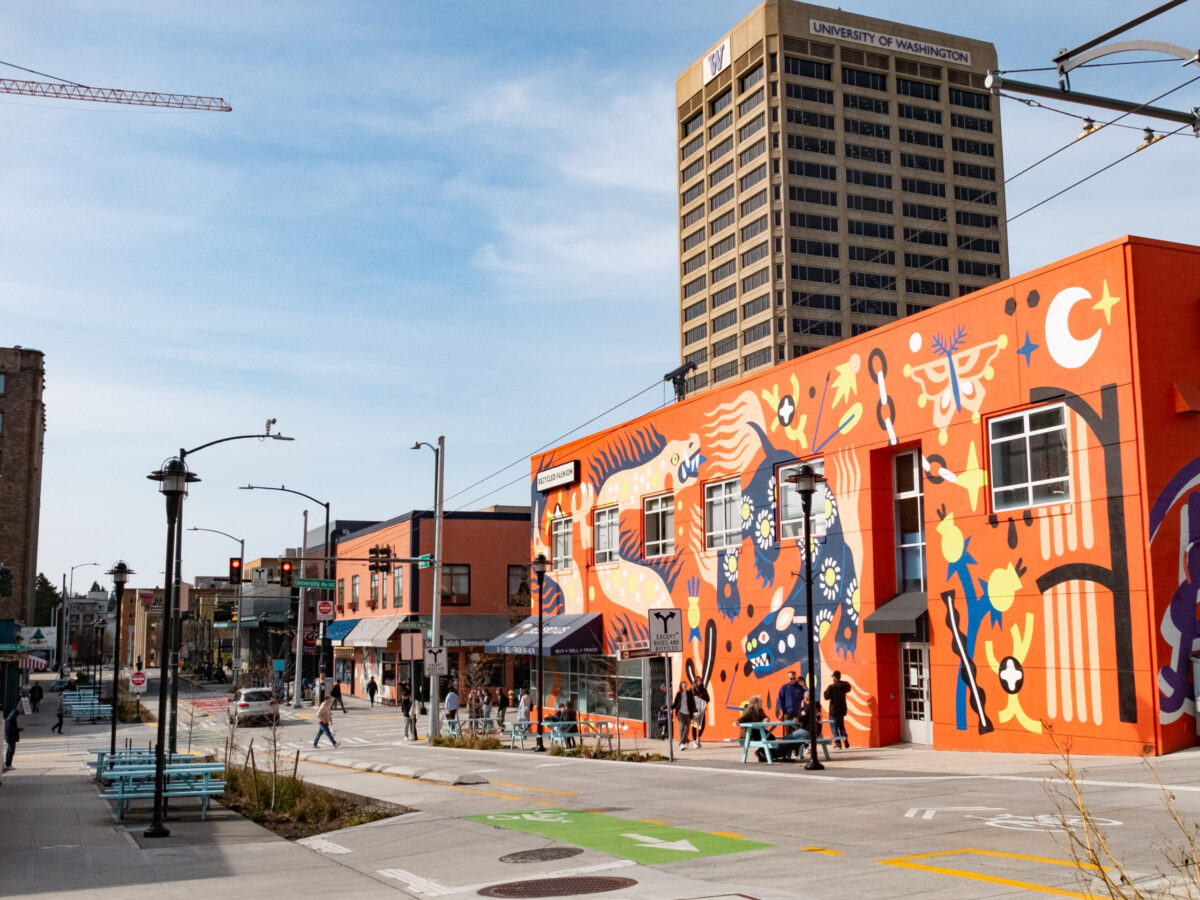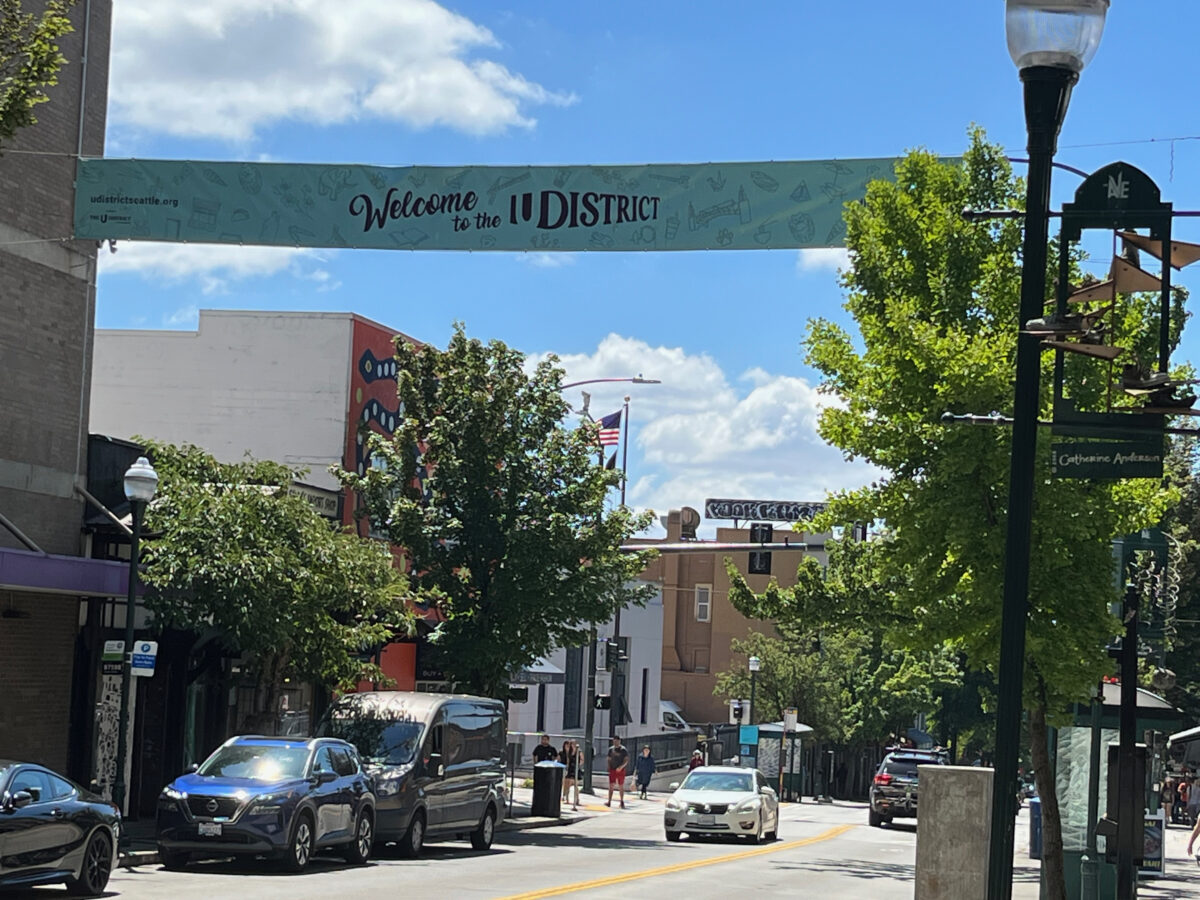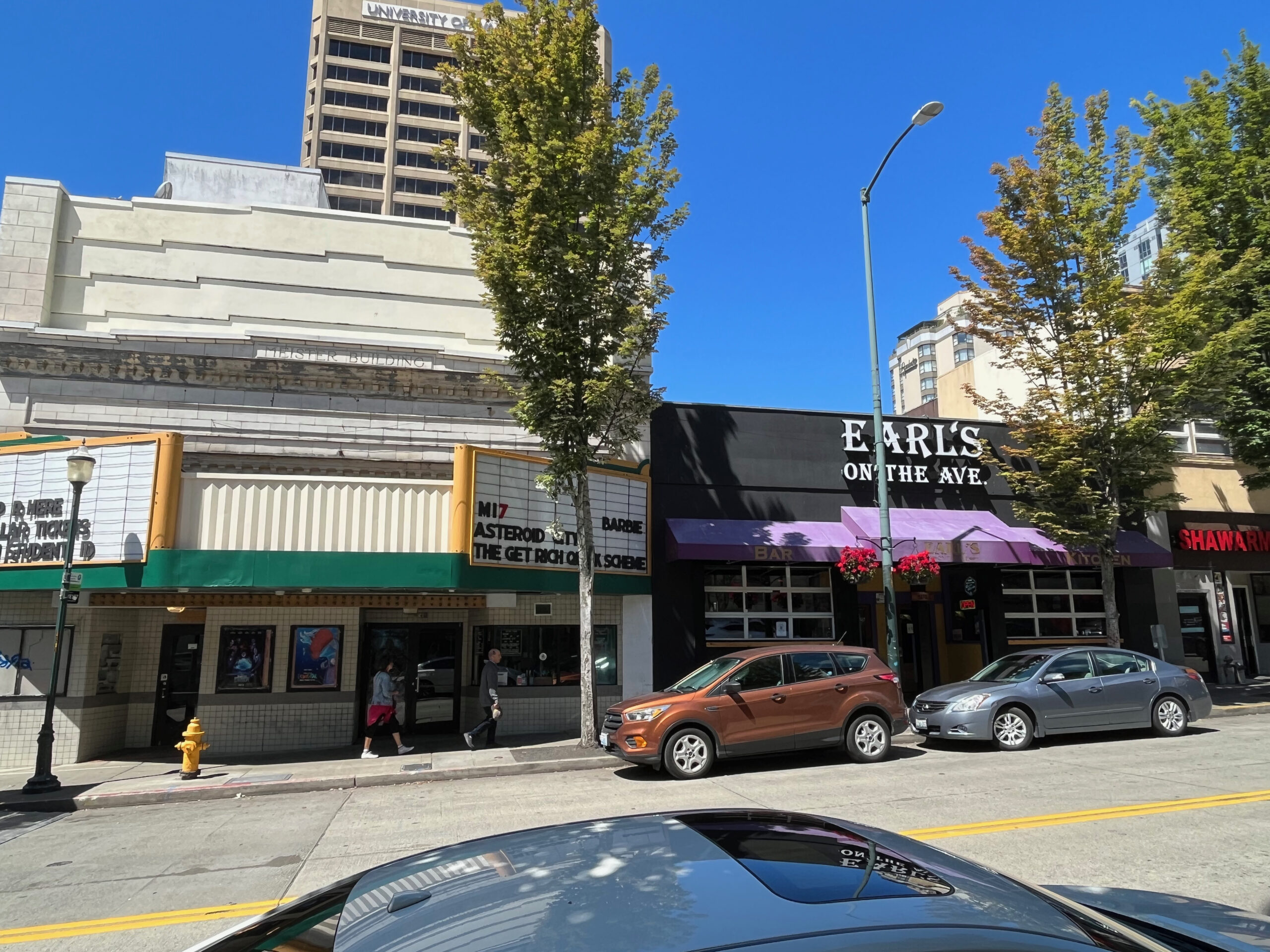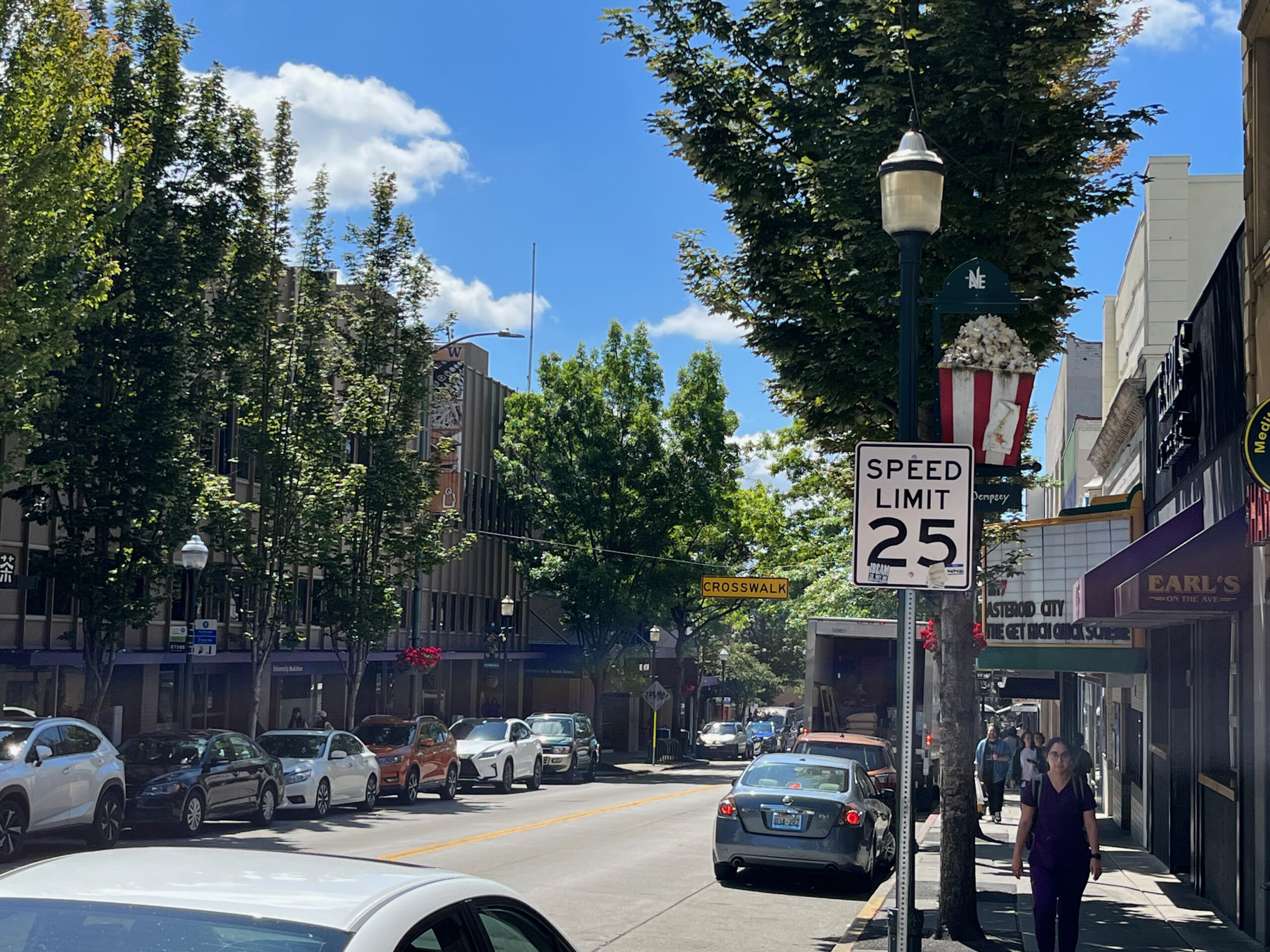Posted on August 24, 2023
Post categories: Community Urban Design & Planning

By the time the pandemic started to recede in early 2022, the main drag of Seattle’s University District had fallen into disconcerting disrepair. Once celebrated as a thriving nucleus of culture and community, the Ave, formally known as University Way, had been slowly declining for decades. The signs were everywhere, from security concerns to increasing homelessness and flagging retail trade. The pandemic only made things worse. Empty storefronts. Rundown façades. A gloomy feeling in general.
Meanwhile, rising housing costs have made it harder for UW students to live in the neighborhood, and the 2021 opening of a new light rail station has made commuting to the area much easier. As a result, many undergraduate students now choose to live outside the U-District after their freshman year; UW currently has the lowest percentage of undergraduate students living in university housing in the Pac-12.
The U-District Partnership (UDP)—a nonprofit organization dedicated to the neighborhood’s vibrancy, diversity, and health—is one of various forces working to turn the Ave around. For several years, UDP has sought to figure out what kinds of investments and interventions might help bring optimism back to the primary corridor between 41st and 45th Streets. In this effort, UDP reached out to the College of Built Environments for assistance. Might there be a chance to get CBE students involved in devising some solutions?
The answer was yes. In Winter 2022, a group of students enrolled in a studio course that studied the challenges the U-District was facing. The following quarter, Teaching Affiliate David Blum led a diverse team of 16 urban planning graduate students through the process of assessing potential improvement strategies. The studio would give them a chance to apply their growing expertise to a place that mattered to them personally.

“It’s not just an academic exercise,” Blum says of the studio. “Students want to be in a profession that is going to make things better, but you’re not going to make the world better unless you do something real.”
The students in the studio embarked on their work with a clear goal in mind: to enhance housing, amenities, and the overall economic vitality of the Ave. They met with UDP staff, as well as people from the UW Alumni Association, and the University Bookstore (one of the Ave’s largest businesses) to inform their ideas. They researched zoning and building codes, market data in the residential and retail sectors, transit ridership, housing affordability, and more. Ultimately, they authored a set of recommendations for neighborhood interventions, affordable housing development, market-rate development, and adaptive reuse—all of which could be executed through the combined efforts of the community, property owners, public sector, and the UDP. “It really was a positive, cathartic effort,” Blum says.
Neighborhood interventions focused on making the Ave inviting and accessible to visitors and customers. The UDP had already created street fairs, murals, and a 43rd Street “woonerf,” a type of living street that originated in the Netherlands and Belgium. The studio looked for ways to build on those successes, envisioning additional placemaking efforts and pedestrian opportunities that would create a cohesive “walkshed” between the U-District light rail station and the Ave.
Some interventions aimed to give more character to each block of the Ave and inspire property owners to maintain their façades. The students recommended themes for three key blocks: academia, local spirit and history, and natural landscape—each with its own specialty crosswalk. (Imagine books or cherry blossoms painted across the street!) The students also suggested various policy changes to increase bike parking, lower the speed limit, and create regular temporary street closures.

“The studio is a perfect lab,” says Katy Ricchiuto, Urban Vitality Manager for the UDP. “The students teach me to think outside the box about what’s possible.” Indeed, soon after the quarter ended, the UDP used student recommendations to secure a grant of nearly $5 million from the Washington State Department of Commerce. The UDP has since granted those funds to 140 ground floor-businesses in the neighborhood, supporting projects such as awning removal or replacement, signage, window replacement, façade painting, and outdoor dining structures. Today the Ave is dotted with “streeteries” and lined with an array of clean, colorful new storefronts.
Turning its attention to affordable housing, the studio evaluated the development potential of a Sound Transit property at 1000 NE 45th Street, which currently provides space for a Tiny House village sheltering about 50 people. The site stood out for its unique development potential, following the 2018 passage of SHB 2382, legislation that allows publicly owned land to be sold at a below market rate to create permanent affordable housing. Studio students conducted a feasibility study for development of permanent supportive housing on this site, assessing zoning requirements such as building height and floor area ratios (FAR), among other criteria. Students then produced two distinct development proposals for Sound Transit and nonprofit developers to consider as they move forward.
The first development proposal calls for the land to be purchased by either the City of Seattle Office of Housing or the King County Regional Homelessness Authority. Once the land has been transferred to one of those agencies, it will issue a Request for Proposals, and eventually the land will be sold to a nonprofit developer who specializes in building permanent supportive housing. This development proposal would include a minimum of 150 studio apartments and 85 one bedroom units, ground floor commercial space and wrap-around supportive services. The second development proposal for the Sound Transit property is for an affordable housing project that includes integrated art space and rental apartments: 100 studios, 50 one bedroom and 15 three-bedroom units. To date, Sound Transit has yet to announce plans for development of this property once the existing Tiny House Village lease expires.
The CBE studio also researched and designed two market rate housing developments for prime real estate located directly on the Ave. Both proposals took into account existing zoning code and the pressing need for mixed-use space in the area. They also included potential development incentives, specifically Seattle’s “Multifamily Tax Exemption” program and green building allowances for increased FAR and building heights.
One site, which they dubbed “Flowers+”, sits at the former location of the longtime Flowers Bar and Restaurant. Flowers has closed, but space has been repainted and several other building improvements have been made to the property. At the other site, called “Big Red,” a large vacant building on the corner of 42nd Street had become a fire and safety hazard. In the months following the CBE studio project, Big Red was demolished. For now, the location is a paid public parking lot.
 The final piece of the studio’s development strategies considers the future of the University Book Store, which is slated to move into a new tower being developed on its current parking lot behind the store. The Book Store currently occupies a series of several small connected buildings, some dating back more than 100 years. When the Book Store relocates, what will become of that large space? The studio envisioned a vibrant hub of activity for students, tourists, and neighborhood residents, complete with a food hall and market, business incubator, makerspace workshop, rooftop hangout equipped for live music, and more. In time, perhaps the Book Store will make it a reality with partners in the private and public sectors.
The final piece of the studio’s development strategies considers the future of the University Book Store, which is slated to move into a new tower being developed on its current parking lot behind the store. The Book Store currently occupies a series of several small connected buildings, some dating back more than 100 years. When the Book Store relocates, what will become of that large space? The studio envisioned a vibrant hub of activity for students, tourists, and neighborhood residents, complete with a food hall and market, business incubator, makerspace workshop, rooftop hangout equipped for live music, and more. In time, perhaps the Book Store will make it a reality with partners in the private and public sectors.
For now, the Ave is trending upward. At lunchtime on a recent summer Wednesday afternoon, it teemed with people and an upbeat vibe, the sidewalks smelling of coffee and shawarma. A pair of Gen Z women walked past the Varsity Theater marquee where Barbie was playing, and one turned to the other: “This area is just so cool.”
To learn more, check out the project’s website, created by the students in the spring 2022 studio.